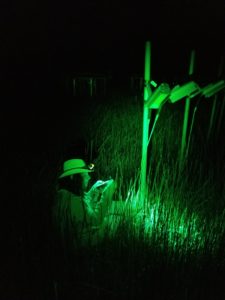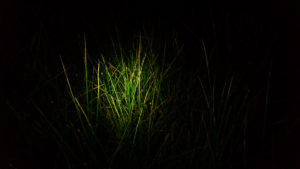By Philip Kiefer
Stress is universal – possibly the most constant aspect of life on Earth. And it’s not just for things with a brainstem. Plants are constantly reacting to their environments; they’re just more private about it. They’re constantly adjusting internal chemical signals, redistributing sugar and water, and sometimes jettisoning unneeded bits in the name of survival.
Lyntana Brougham, a visiting scientist at the Smithsonian Environmental Research Center (SERC), is using these stress responses to look inside a salt marsh. By understanding how marsh plants like cordgrasses and sedges respond to higher temperatures, she hopes to develop a clearer picture of how climate change may stress the marsh as a whole.
When the sun comes up over a salt marsh, the cordgrass has to make a series of cascading decisions. First, should it begin to photosynthesize, to make the sugars it needs to grow? If it does, it will need carbon dioxide, which means opening thousands of breathing pores – stomata – on the underside of its leaves. But opening the stomata allows water to escape into the air. What to do if water is scarce – if a hot day is causing water to evaporate quickly?
So, better to keep the stomata closed in hot weather. But that causes a new problem: The leaves are full of chlorophyll, the green pigment that drives photosynthesis. With photosynthesis on hold, the chlorophyll has nothing to do with the light energy it absorbs. Like a black coat on a sunny day, it traps light energy in the leaves, causing runaway chemical reactions that can poison the plant from the inside. If the plant is stressed about conserving water, it has to find something to do with all that spare energy.
The plant can’t just dump the chlorophyll from its leaves, so instead, it’s developed a sort of internal safety valve. A network of antennae-like proteins around the chlorophyll can take light energy and pour it back into the world. When there’s a slowdown in photosynthesis, say because carbon dioxide is limited, these antennae spit energy back as light and heat, a process called “chlorophyll fluorescence.”
Understanding how plants react to heat is crucial to predicting how marshes as a whole will fare in coming decades. Increased temperatures will put plants in newly stressful situations worldwide. And if marsh plants grow more slowly in a warming atmosphere, they can’t build soil, and the ecosystem is more likely to drown as sea levels rise.
Brougham does her work on SERC’s Global Change Research Wetland, or “wetland of the future,” where scientists are exposing patches of the marsh to higher temperatures to emulate possible warming scenarios. She’s looking to understand how added heat stress affects individual plants, and use that to predict how the marsh as a whole will react to climate change.

Chambers on the GCREW marsh simulate the stressful environmental conditions of climate change. (Philip Kiefer/SERC)
But directly measuring photosynthesis in plants is onerous. She spent last summer out on the marsh working with a tool that can measure the exact photosynthetic rate of each leaf. The tool was powerful in the way that a glacier is powerful: extremely slowly. It would have taken every minute of the summer to measure enough plants to be confident in her results.
This summer, she’s taking a more indirect route, using the plant stress to approximate photosynthesis. When a plant decides to shut down photosynthesis, it holds onto light and heat differently. Brougham can measure how much light they’re fluorescing by flashing the leaves with a bright light. This gives her a measure of how much light they’re holding onto. If the plant’s gobbling up light, then it’s photosynthesizing happily. If it’s dumping it back out immediately, something’s gone wrong.
Ironically, she has to measure the plants’ response to sunlight in the middle of the night. This is because plants are constantly modulating their response to sunlight over the course of the day, making for inconsistent measurements.

Lyntana Brougham, a SERC visiting scientist, records stress levels in marsh plants. Because plants respond to light differently over the course of the day, Brougham has to take all her measurements in the dead of night. (Genevieve Noyce/SERC)
“Plants go through a midday depression,” Brougham says. They get exhausted and have to cool off before restarting photosynthesis, which makes for noisy data. It’s easier to see baseline stress levels by waking the plants up with a flash of light.
“My whole day is sandwiched between trips to the marsh,” Brougham says. On data collection days, she’s at the marsh at 1 a.m., sleeps for a few hours, and then heads back out for more. She didn’t expect to like the nighttime marsh, but there have been upsides. She’s been watching Jupiter and Mars get higher in the sky, and she likes getting to know the spiders that come out in the dark.
So far, the data is inconclusive. Brougham’s hunch is that hotter temperatures will put more stress on photosynthesis, inhibiting marsh growth, but it will take time to be sure.
The goal, she says, “is to give more data to modelers, so that they have a better sense of what’s happening in the marsh.” Better models can help predict how quickly marshes can grow in response to rising sea levels, or to estimate how much carbon wetlands can absorb from the atmosphere. Previous experiments on plant growth and climate have involved observing plant growth over the course of months or years. According to Brougham, the approach might be a faster way to measure the effect of warming on plant health.
Stressed-out photosynthesizers are a bad thing for the marsh. Coastal wetlands live in a precarious balance: They need salt water to exist, but can drown in rising seas if they don’t grow quickly enough. The future of the marsh may ultimately depend on the vitality of the plants – whether they are hardy enough to outpace the tides, or wilt in a warming atmosphere.


